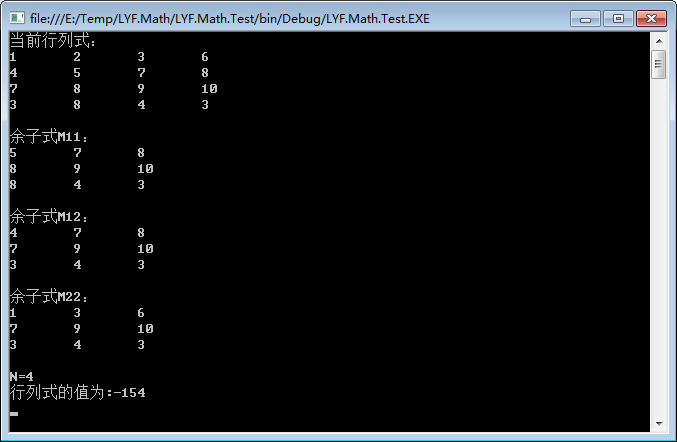線性代數之行列式的C#研究實現
阿新 • • 發佈:2017-11-21
學習 ops {0} builder att interop turn gen new
最近學習機器學習 才發現以前數學沒有學好 開始從線性代數開始學起 讀完行列式一章寫了些C#的代碼學習一下。
直接上C#代碼:
using System;
using System.Collections.Generic;
using System.Linq;
using System.Text;
using System.Runtime.InteropServices;
using System.IO;
namespace LYF.Math
{
/// <summary>
/// 行列式 Determinant
/// </summary>
[SerializableAttribute]
[ComVisibleAttribute(true)]
public class Determinant<T> where T : IComparable, IFormattable, IConvertible, IComparable<T>, IEquatable<T>
{
T[,] tarr = null;
public Determinant(int n)
{
tarr = new T[n, n];
}
public Determinant(T[,] arrT)
{
if (arrT == null || arrT.GetLength(0) != arrT.GetLength(1) || arrT.GetLength(0) < 1)
{
throw new MathException("不正確的數組(數組必須行列數相同且大於1)");
}
else
{
tarr=new T[arrT.GetLength(0),arrT.GetLength(0)];
SetItem(arrT);
}
}
/// <summary>
/// 獲取元素值
/// </summary>
/// <param name="i"></param>
/// <param name="j"></param>
/// <returns></returns>
public T this[int i, int j]
{
//實現索引器的get方法
get
{
return GetItem(i, j);
}
//實現索引器的set方法
set
{
SetItem(i, j, value);
}
}
/// <summary>
/// 獲取元素的余子式
/// </summary>
/// <param name="i"></param>
/// <param name="j"></param>
/// <returns></returns>
public Determinant<T> A(int i, int j)
{
if (N == 1)
{
return null;
}
else if (i>N||j>N)
{
return null;
}
else
{
Determinant<T> a = new Determinant<T>(N - 1);
for (int m = 1; m <= N - 1; m++)
{
for (int n = 1; n <= N - 1; n++)
{
int p = m, q = n;
if (p >= i)
{
p = m + 1;
}
if (q >= j)
{
q = n + 1;
}
a[m, n] = this[p,q];
}
}
return a;
}
}
/// <summary>
/// 設置行列式的值
/// </summary>
/// <param name="i">行數(從1開始)</param>
/// <param name="j">列數(從1開始)</param>
/// <param name="value">值</param>
public void SetItem(int i, int j, T value)
{
if (tarr == null)
{
throw new MathException("行列式未正確初始化");
}
else if (i > N || j > N)
{
throw new MathException("超出行列式索引範圍");
}
else
{
tarr[i - 1, j - 1] = value;
}
}
public void SetItem(T[,] arrT)
{
if (arrT == null || tarr == null)
{
throw new MathException("不能為空");
}
else if (arrT.GetLength(0) != N || arrT.GetLength(1) != N)
{
throw new MathException("傳入階數不同");
}
else
{
for (int m = 0; m <=N-1; m++)
{
for (int n = 0; n <= N- 1; n++)
{
this[m + 1, n + 1] = arrT[m, n];
}
}
}
}
/// <summary>
/// 設置行列式的值
/// </summary>
/// <param name="i">行數(從1開始)</param>
/// <param name="j">列數(從1開始)</param>
/// <param name="value">值</param>
public T GetItem(int i, int j)
{
if (tarr == null)
{
throw new MathException("行列式未正確初始化");
}
else if (i > N || j > N)
{
throw new MathException("超出行列式索引範圍");
}
else
{
return tarr[i-1, j-1];
}
}
/// <summary>
/// 輸出行列式信息
/// </summary>
/// <returns></returns>
public override string ToString()
{
StringBuilder sbRs = new StringBuilder();
if(tarr!=null)
{
for (int m = 0; m <= N - 1; m++)
{
for (int n = 0; n <= N - 1; n++)
{
sbRs.Append(string.Format("{0}\t", tarr[m, n]));
}
sbRs.Append("\n");
}
}
return sbRs.ToString();
}
/// <summary>
/// 獲取行列式的階數
/// </summary>
public int N
{
get{
if (tarr != null)
{
return tarr.GetLength(0);
}
else
{
return 0;
}
}
}
private string typeName = string.Empty;
private string GetType()
{
if (string.IsNullOrEmpty(typeName))
{
typeName=typeof(T).Name;
File.AppendAllText("E:\\op.txt", typeName);
}
return typeName;
}
/// <summary>
/// 獲取行列式的值
/// </summary>
public T Value
{
get
{
if (N == 1)
{
return tarr[0, 0];
}
else if (N == 2)
{
return Minus(MUL(tarr[0, 0], tarr[1, 1]), MUL(tarr[0, 1], tarr[1, 0]));
}
else
{
T sum = default(T);
for (int i = 1; i <= N; i++)
{
if ((1+i) % 2 == 0)
{
//余子式正值
sum = Add(sum, MUL(this[1, i], this.A(1, i).Value));
}
else
{
//余子式負值
sum = Minus(sum, MUL(this[1, i], this.A(1, i).Value));
}
}
return sum;
}
}
}
/// <summary>
/// 加法
/// </summary>
/// <param name="left"></param>
/// <param name="right"></param>
/// <returns></returns>
private T Add(T left, T right)
{
switch (GetType())
{
case "Int16":
return ((T)(object)((short)(object)left + (short)(object)right));
case "Int32":
return ((T)(object)((int)(object)left + (int)(object)right));
case "Int64":
return ((T)(object)((long)(object)left + (long)(object)right));
case "Single":
return ((T)(object)((float)(object)left + (float)(object)right));
case "Double":
return ((T)(object)((double)(object)left + (double)(object)right));
case "Decimal":
return ((T)(object)((decimal)(object)left + (decimal)(object)right));
}
throw new MathException("不支持的操作類型");
}
/// <summary>
/// 減法
/// </summary>
/// <param name="left"></param>
/// <param name="right"></param>
/// <returns></returns>
private T Minus(T left, T right)
{
switch (GetType())
{
case "Int16":
return ((T)(object)((short)(object)left - (short)(object)right));
case "Int32":
return ((T)(object)((int)(object)left - (int)(object)right));
case "Int64":
return ((T)(object)((long)(object)left - (long)(object)right));
case "Single":
return ((T)(object)((float)(object)left - (float)(object)right));
case "Double":
return ((T)(object)((double)(object)left - (double)(object)right));
case "Decimal":
return ((T)(object)((decimal)(object)left - (decimal)(object)right));
}
throw new MathException("不支持的操作類型");
}
/// <summary>
/// 乘法
/// </summary>
/// <param name="left"></param>
/// <param name="right"></param>
/// <returns></returns>
private T MUL(T left, T right)
{
switch (GetType())
{
case "Int16":
return ((T)(object)((short)(object)left * (short)(object)right));
case "Int32":
return ((T)(object)((int)(object)left * (int)(object)right));
case "Int64":
return ((T)(object)((long)(object)left * (long)(object)right));
case "Single":
return ((T)(object)((float)(object)left * (float)(object)right));
case "Double":
return ((T)(object)((double)(object)left * (double)(object)right));
case "Decimal":
return ((T)(object)((decimal)(object)left * (decimal)(object)right));
}
throw new MathException("不支持的操作類型");
}
}
}
以上代碼就是對行列式的封裝 可以求值獲得余子式 很基本的東西 求值的話主要用了遞歸的方式 因為泛型的原因導致計算過程重復拆箱裝箱 不過目前好像也沒有什麽太好的方法了。反正就是學習 所以性能無所謂了。
然後就是調用了直接上調用代碼:
int[,] aaa = new int[4, 4]{{1,2,3,6},
{4,5,7,8},
{7,8,9,10},
{3,8,4,3}};
//LYF.Math.Determinant<int> d = new Determinant<int>(4);
LYF.Math.Determinant<int> d = new Determinant<int>(aaa);
d.SetItem(aaa);
Console.WriteLine("當前行列式:");
Console.WriteLine(d.ToString());
Console.WriteLine("余子式M11:");
Console.WriteLine(d.A(1, 1).ToString());
Console.WriteLine("余子式M12:");
Console.WriteLine(d.A(1, 2).ToString());
Console.WriteLine("余子式M22:");
Console.WriteLine(d.A(2, 2).ToString());
Console.WriteLine("N="+d.N);
Console.WriteLine("行列式的值為:"+d.Value.ToString());
Console.Read();
執行結果如下:

線性代數之行列式的C#研究實現
